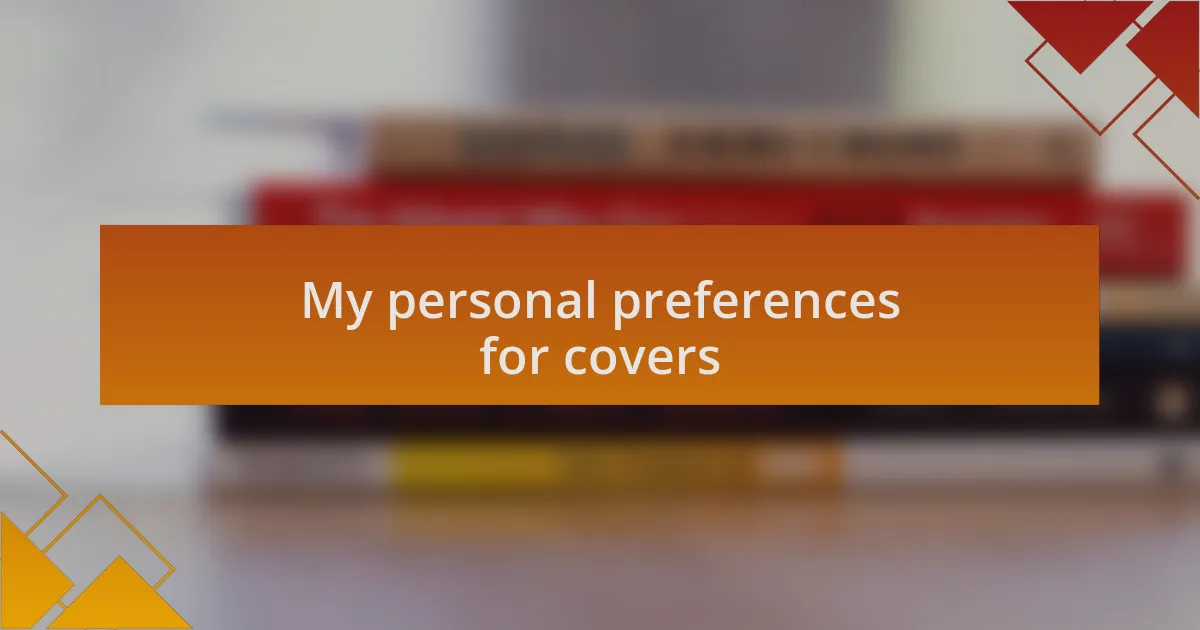Key takeaways:
- Book cover design is a crucial tool that conveys the essence of a story, impacting reader attraction and engagement.
- Key elements of effective design include color, typography, imagery, and the balance between simplicity and complexity, all of which contribute to a book’s narrative portrayal.
- Personal preferences for covers often include storytelling elements, hand-drawn illustrations, and tactile features that create a deeper connection with readers.
- Covers influence reader perceptions of genre and themes, impacting initial expectations and reader loyalty through cohesive visual identities.

Understanding book cover design
Book cover design is more than just an aesthetic choice; it’s a powerful tool that conveys the essence of a story. I remember the first time I picked up a book solely because its cover caught my eye. That moment taught me how crucial visual appeal is in attracting readers and how a well-designed cover can set the tone long before the first page is turned.
Each element of a book cover—from typography to imagery—serves a specific purpose. When I explore different covers, I often wonder what the designer intended to convey about the book’s theme. For example, a minimalist cover might suggest a deep, introspective narrative, while vibrant designs can hint at adventure and excitement. It’s fascinating how much thought goes into such details, isn’t it?
Moreover, understanding the target audience plays a significant role in design choices. When I designed a cover for my last project, I had to consider not just what I liked, but what would resonate with my readers. This experience underscored for me that a successful cover speaks not just to the author but directly to the reader, forging a connection that can spark curiosity and invite them into the world within the pages.

Key elements of effective designs
Effective book cover designs hinge on the synergy of color, typography, and imagery. I once experimented with color choices for a cover I was working on, and chose a deep blue to evoke a sense of calm and mystery. It was remarkable how just that one decision shifted the way potential readers reacted to the design, making me appreciate the emotional weight colors carry in storytelling.
Another vital element is the balance between simplicity and complexity. I often find myself drawn to covers that either embrace a clean design or thoughtfully layer images for depth. In one project, I opted for a clean typeface alongside an intricate illustration, which not only caught the eye but also sparked a conversation about the book’s deeper meanings. Have you ever noticed how a well-placed element can completely transform a viewer’s understanding?
Lastly, storytelling through design is critical. When designing covers, I always keep in mind that every element should hint at the book’s narrative. I once chose an image of an open door for a fantasy novel, symbolizing new worlds waiting to be explored. That choice resonated with readers; it made them wonder, “What lies beyond?” It’s a reminder that a good cover doesn’t just look appealing; it invites readers into an experience.

My personal preferences for covers
When it comes to book covers, I’m particularly drawn to designs that tell a story at first glance. One of my favorite covers featured a stark, black-and-white photograph that elicited such a strong emotional response from me that I found myself unable to resist picking the book up. Have you ever experienced that instant connection where a cover speaks to you and makes you curious about its contents? It’s quite captivating how a visual element can spark such intrigue.
I also have a soft spot for covers that incorporate hand-drawn illustrations. There’s something intimate and inviting about them. For example, I once designed a cover featuring a whimsical illustration of a cat sitting atop a stack of books. It felt personal, almost like a snapshot of my own love for reading. I think these artistic touches can create a unique bond between the reader and the story—don’t you agree that they add a layer of warmth that digital art sometimes lacks?
Moreover, I prefer covers that are not only beautiful but also functional. I remember a time when I encountered a cover that used embossing to create a tactile experience. Touching the design heightened my interest and made the book feel more special. I believe that adding such elements can transform a cover from simply visually striking to a multi-sensory experience. What do you think—do you find yourself more engaged with a cover that invites touch?

How covers impact reader perception
A cover often signals the genre and themes within a book, influencing initial expectations. I recall a time when I picked up a thriller with a dark, moody cover, which instantly made me anticipate suspense and intrigue. It’s fascinating how color choices and typography play into this perception—don’t you think a bright, vibrant cover might suggest a lighthearted story, while muted tones often hint at deeper, more serious narratives?
The imagery used on covers can also evoke emotional responses that draw readers in. I once stumbled upon a cover featuring an ethereal landscape that reminded me of a dream I had as a child. This connection made me more inclined to explore the story, as the cover seemed to promise an escape into a world of imagination. How many times have you felt that pull from a striking image or compelling design?
Interestingly, I find that covers can impact reader loyalty as well. I remember feeling a strong attachment to a book series where each cover was beautifully cohesive. This visual unity not only appealed to my aesthetic sense but also made me feel as though I was part of a larger narrative journey. When a series has a distinct visual identity, it fosters a sense of belonging—did you ever find yourself seeking out a sequel just because the cover felt like an old friend?